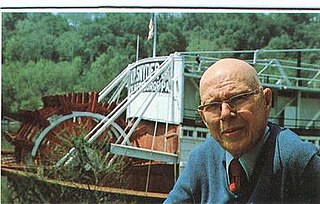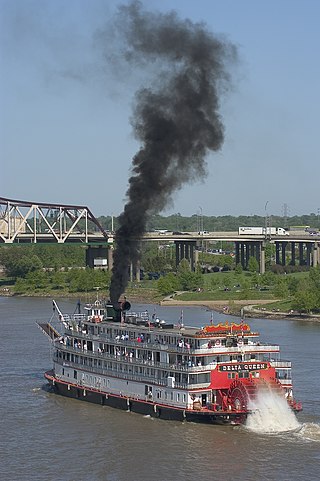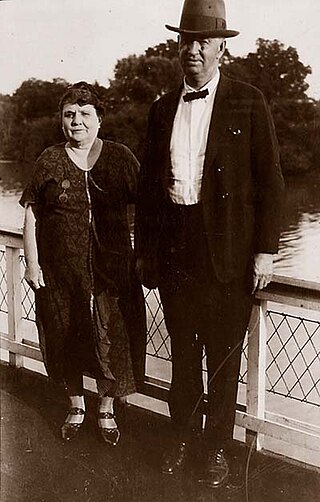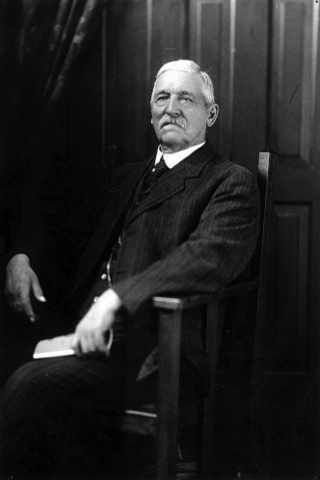The topic of this article may not meet Wikipedia's notability guideline for biographies .(March 2014) |
Captain Christopher Becker Greene (1901 - October 20, 1944) was the head of the Greene Line of steamboats after the death of his father. [1] [2]
The topic of this article may not meet Wikipedia's notability guideline for biographies .(March 2014) |
Captain Christopher Becker Greene (1901 - October 20, 1944) was the head of the Greene Line of steamboats after the death of his father. [1] [2]
He was born in 1901 in Ohio to Mary Catherine Becker and Gordon Christopher Greene, and his brother was Thomas Rea Greene. [1] In 1928 he raced Frederick Way, Jr. [3] He died on October 20, 1944. [2]

Robert Fulton was an American engineer and inventor who is widely credited with developing the world's first commercially successful steamboat, the North River Steamboat. In 1807, that steamboat traveled on the Hudson River with passengers from New York City to Albany and back again, a round trip of 300 nautical miles, in 62 hours. The success of his steamboat changed river traffic and trade on major American rivers.

Oliver Hazard Perry was a United States Navy officer from South Kingstown, Rhode Island. A prominent member of the Perry family naval dynasty, he was the son of Sarah Wallace Alexander and Captain Christopher Raymond Perry, and older brother of Commodore Matthew C. Perry.

A steamboat is a boat that is propelled primarily by steam power, typically driving propellers or paddlewheels. The term steamboat is used to refer to small steam-powered vessels working on lakes, rivers, and in short-sea shipping. The development of the steamboat led to the larger steamship, which is a seaworthy and often ocean-going ship.

Belle of Louisville is a steamboat owned and operated by the city of Louisville, Kentucky, and moored at its downtown wharf next to the Riverfront Plaza/Belvedere during its annual operational period. The steamboat claims itself the "most widely traveled river steamboat in American history." Belle of Louisville's offices are aboard Mayor Andrew Broaddus, and also appears on the list of National Historic Landmarks.

Delta Queen is an American sternwheel steamboat. She is known for cruising the major rivers that constitute the tributaries of the Mississippi River, particularly in the American South, although she began service in California on the Sacramento River delta for which she gets her name. She was docked in Chattanooga, Tennessee and served as a floating hotel until purchased by the newly formed Delta Queen Steamboat Company. She was towed to Houma, Louisiana, in March 2015 for refurbishing to her original condition.

Edward Knight Collins I was an American shipping magnate.

Fredrick Way Jr. was the youngest steamboat captain on the Ohio River and Mississippi River. He was the author of books on the boats that ply the inland waterways. He supervised the flat-bottom, stern paddlewheeler, the Delta Queen, from San Francisco, down the Pacific coast, through the Panama Canal, across the Gulf of Mexico and up the Mississippi and Ohio rivers to Pittsburgh in 1946.

Matthew McDowell was a steamboat owner and builder associated with the Puget Sound Mosquito Fleet.

Joseph Reynolds was an American entrepreneur and founder of the Diamond Jo Line, a transportation company which operated steamboats on the upper Mississippi River. In his youth, while still living in upstate New York, he operated a butchery, a general store, a grain mill, and a tannery.

The H. K Bedford was a passenger and trade ship of the Greene Line.

Captain Gordon Christopher Greene, was the owner of the Greene Line of river steamboats.
Gordon C. Greene was a paddle steamer, launched in 1923, that operated under several names before sinking in St. Louis in 1967.

Captain Thomas Rea Greene was president of the Greene Line of steamboats.

The Greene Line was a line of river steamships along the Ohio River. The name was changed in 1973 to Delta Queen Steamboat Company.

Captain Mary Becker Greene, was steamboat captain of the Greene Line of river steamboats. She was the only female steamboat captain in Ohio.

Grant Prince Marsh was a riverboat pilot and captain who was noted for his many piloting exploits on the upper Missouri River and the Yellowstone River in the Western United States from 1862 until 1882. He began working as a cabin boy in 1856, eventually becoming a captain, pilot, and owner in a career lasting over sixty years. During that time, he achieved an outstanding record and reputation as a steamboat captain, serving on more than 22 vessels. His piloting exploits became legendary and modern historians have referred to him as "possibly the greatest steamboat man ever", "possibly the greatest [steamboat pilot] ever", "possibly the finest riverboat pilot who ever lived", and "the greatest steamboat master and pilot on both the Missouri and Yellowstone Rivers".
Horace Ezra Bixby was a steamboat pilot on the Mississippi-Missouri-Ohio river system from the late 1840s until his death in 1912. Bixby is notable in his own right for his high standing in his profession, for his technical contributions to it, and for his service in the American Civil War. However, he is best known for having had as his "cub pilot" the young man known to him as Sam Clemens, later to become famous under his pen name as American author Mark Twain. Twain's descriptions of Bixby's character and pedagogic style form a good part of his memoir Life on the Mississippi, and it was through this medium that Bixby—much to his annoyance—became well-known beyond the circles of his family, friends and profession.
Mary Greene may refer to:
Streckfus Steamers was a company started in 1910 by John Streckfus Sr. (1856–1925) born in Edgington, Illinois. He started a steam packet business in the 1880s, but transitioned his fleet to the river excursion business around the turn of the century. In 1907, he incorporated Streckfus Steamers to raise capital and expand his riverboat excursion business. A few years later, the firm acquired the Diamond Jo Line, a steamboat packet company.

The Betsy Ann was a sternwheel packet, next a towboat and finally an excursion boat. She was built by Iowa Iron Works in 1899. She is best remembered for participating in three steamboat races. She lasted 41 years, until 1940, when she was dismantled at the St. Louis Wharf. The Betsy Ann was the subject of the book The Log of the Betsy Ann, by Fred Way, former captain of the boat. She ran on the Ohio River from Pittsburgh to Portsmouth, Ohio.
The occasion was a race between the Betsy Ann and the Chris Greene, two packets plying the Ohio between Cincinnati and Pittsburgh. Captain Chris Greene of the Chris Greene had boasted that his vessel, a steel craft built in 1925, could beat the Betsy Ann 'any time.' ...